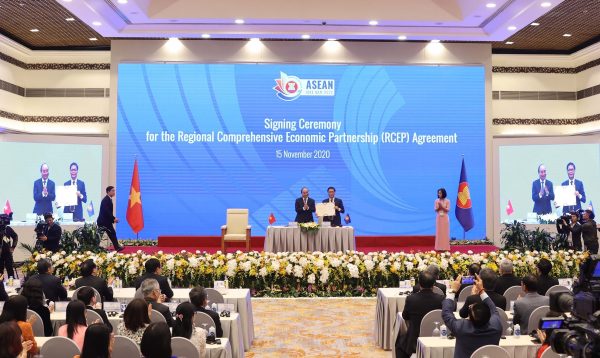The European Union and United States are not direct participants to RCEP, yet they are Cambodia’s first and second largest importers respectively, jointly accounting for 70 per cent of Cambodia’s exports. This includes 76 per cent of Cambodia’s garment and footwear exports. By contrast, RCEP countries are modest consumers of Cambodia’s products. Japan consumes 8 per cent of Cambodia’s exports, China and India 6 per cent, Australia, New Zealand and South Korea 3 per cent and ASEAN countries make up 9 per cent.
Cambodia’s existing preferential trade arrangements and narrow production and export base indicate that RECP might not substantially boost Cambodia’s market access, at least directly and immediately. Instead, RCEP could become a net competitor to Cambodia rather than expanding export market access.
Still, RCEP’s long-term trade opportunities and benefits will enable Cambodia to modernise and diversify its economic structure. The country’s current engines of growth depend heavily on agriculture, tourism, garment manufacturing and construction. Yet, due to domestic structural and demographic change, as well as rising competition and vulnerability to external shocks, these industries cannot secure high growth for Cambodia indefinitely.
With tariff barriers already low from existing FTAs, non-tariff barriers are of particular concern for Cambodia’s exports. RCEP gives enhanced guidance among members to mitigate non-tariff trade barriers, such as sanitary and phytosanitary measures and technical barriers to trade. These are a direct response to concerns raised by Cambodia’s agricultural exporters, who stand to benefit from a reduction in non-tariff barriers.
Another RCEP benefit is around rules of origin (ROOs). ROOs determine which goods originate under RCEP and are eligible for preferential tariff treatment. Firms operating in RCEP countries where the cost of labour is high will be incentivised to direct outward foreign direct investment (FDI) to countries with low production costs in labour-intensive industries, including garment manufacturing for which Cambodia is specialised in.
In the context of RCEP, Cambodia should look beyond low value-added industries and prioritise inward FDI that might expand medium-skilled and high-skilled industries to capture more value and deepen integration into regional and global value chains. Agro-processing and manufacturing firms from Japan and South Korea should be targeted. Strong backward linkages and spill-over effects from investment will also assist in developing domestic industrial capacity in Cambodia.
RCEP also offers special treatment in terms of technical cooperation, capacity building and implementation flexibility for developing countries. Cambodia, along with Laos and Myanmar, are required to eliminate tariffs on 30 per cent of trade compared to tariff elimination requirements of up to 65 per cent for other members. While other members have 10 years to eliminate 80 per cent of their tariffs, Cambodia has 15 years to prepare itself. RCEP also includes provisions for economic and technical cooperation aimed at narrowing the development gap among members.
Compared to existing preferential trade deals Cambodia is involved in — including the Everything but Arms (EBA) and Generalized System of Preferences (GSP) agreements — RCEP is more extensive and rule-based. As Cambodia develops, the EBA and GSP will, at some point, be phased out. For the Cambodian government, signing RCEP also sends a political message to the European Union and United States. For too long, the Cambodian economy has been dependent on the EBA and GSP.
As Cambodia is expected to reap RCEP’s benefits, so are other ASEAN countries, especially developing countries. Vietnam and Thailand, both efficient large-scale producers and exporters, will increase competition around agricultural exports to RCEP markets. Cambodia should identify market niches for its high-value products to compete. Myanmar, with its low-wage economy, will also be attractive to cost-sensitive investors in the garment industry. Cambodia should make itself ready to seize RCEP’s benefits.
Cambodia’s past FDI success has largely depended on relatively inexpensive labour, fiscal incentives and preferential trade deals. Yet, the prospective conclusion of preferential treatment and rising minimum wages have eroded Cambodia’s competitiveness.
When targeting cost-sensitive investors, Cambodia should explore ways to reduce operation costs, including encouraging competitive energy prices and lower cost logistics. The government must also do more to reduce corruption and improve the investment climate through stronger rules and regulations. Special investment incentives should be granted to firms committed to upskilling employees and enabling technical and knowledge diffusion that enables domestic firms and young people to become the driver of economic revitalisation.
Inefficient and absent regulatory conformity across institutions has also continued to prevent Cambodia from expanding and diversifying its agricultural exports. For example, exports of semi-milled or wholly milled rice, which accounts for 12 per cent of Cambodia’s exports to China, face around 106 non-tariff measures. Similarly, the establishment of quality infrastructure in Cambodia will also help to address non-tariff challenges facing the country’s agricultural exporters.
With imports outpacing exports, Cambodia should keep a close eye on dumping which would be harmful to the country’s domestic industries. Although not all domestic industries are worth supporting, some which are growth promoting and essential to the country’s industrial development policy, such as the rice and bicycle industries, deserve attention.
Concerns that RCEP will bring additional harm to Cambodia’s domestic industries are overblown given that most RCEP members have already established free trade deals with Cambodia. The net benefits more than outweigh any costs.
Heimkhemra Suy is a developmental advisor based in Phnom Penh.

